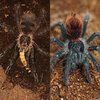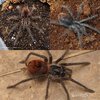- Joined
- Mar 28, 2013
- Messages
- 1,667
I thought I’d share this to make an effort to help shine the light on these species being mislabeled.
Pamphobeteus sp. ‘nigricolor’ (Ecuador) has NO connection to Pamphobeteus nigricolor (true Colombian) or affinis I & II.
There is NO resemblance between the two besides the current genus they’re in. The Ecuador species has a Christmas tree pattern while the true type species does not. Although both are gorgeous spiders, one should be cognizant of the differences between them and not overpay for the species they think they’re getting.
Same thing can be said with Pamphobeteus sp. ‘insignis’ and Pamphobeteus insignis.

Pamphobeteus sp. ‘nigricolor’ (Ecuador) vs. Pamphobeteus nigricolor

Pamphobeteus affinis nigricolor II & Pamphobeteus nigricolor

Pamphobeteus insignis
Pamphobeteus sp. ‘nigricolor’ (Ecuador) has NO connection to Pamphobeteus nigricolor (true Colombian) or affinis I & II.
There is NO resemblance between the two besides the current genus they’re in. The Ecuador species has a Christmas tree pattern while the true type species does not. Although both are gorgeous spiders, one should be cognizant of the differences between them and not overpay for the species they think they’re getting.
Same thing can be said with Pamphobeteus sp. ‘insignis’ and Pamphobeteus insignis.

Pamphobeteus sp. ‘nigricolor’ (Ecuador) vs. Pamphobeteus nigricolor

Pamphobeteus affinis nigricolor II & Pamphobeteus nigricolor

Pamphobeteus insignis

